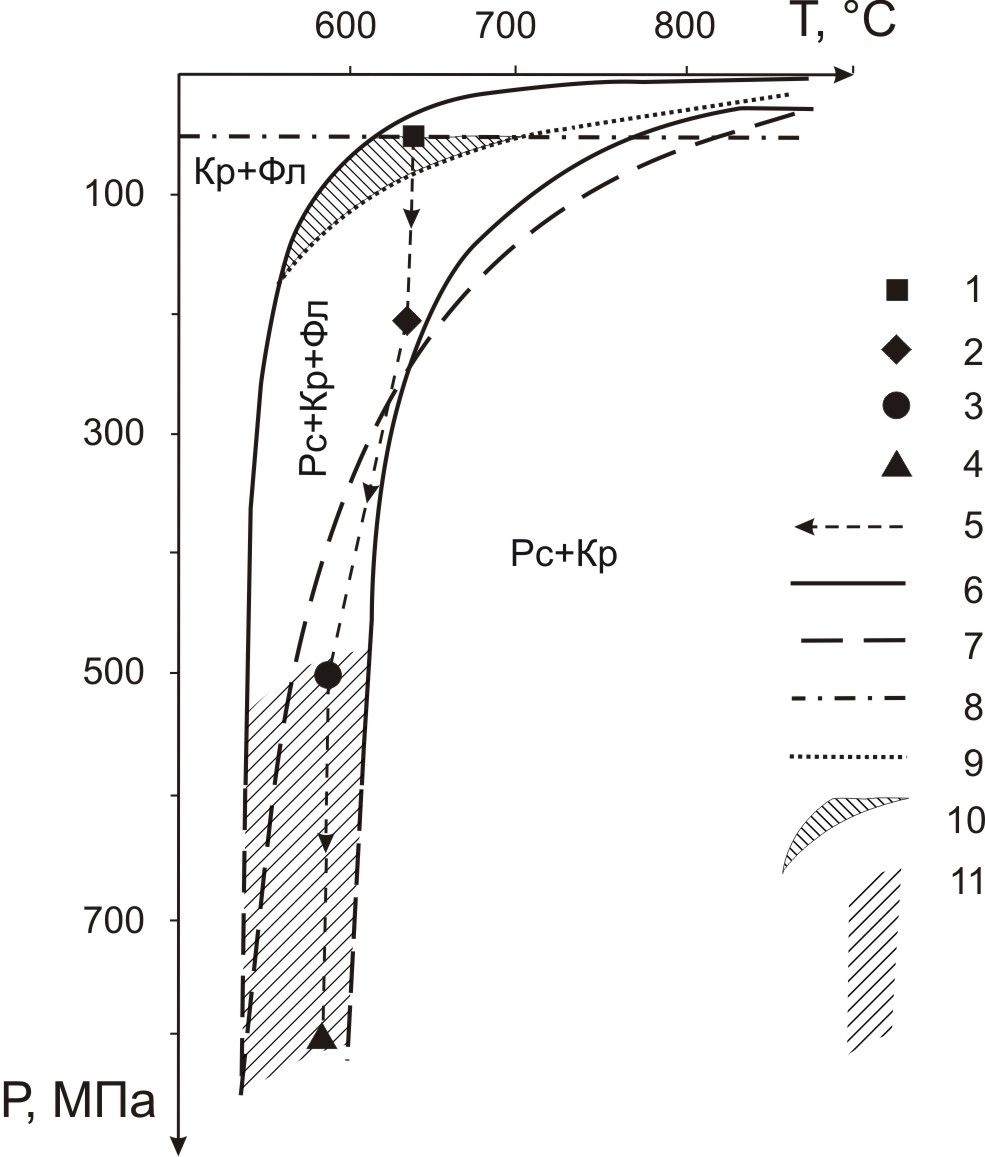|
FLUID SUPER-PRESSURE DURING LITHIUM- FLUORINE GRANITE CRYSTALLIZATION (ON EXAMPLE OF THE SEVERNIY GRANITIC BATHOLITH, CHUKOT)
Sankt-Petersburg State Mining Institute named after G.V.Plekhanov (technical university), Sankt-Petersburg, Russia, wia59@mail.ru
In granitic melts at shallow depths (0,5-3 km) fluid pressure can essentially increase through volatile components escaping. As a result fluid-saturated magmatic systems gain ability to develop explosively and the systems of lithium-fluoric rare-metal melts with water content up to 10-13% and fluorine content – 2,5-3,5 % particularly stand out against them. Granitoids of the Severniy pluton which is situated in Shelagskaya ridge of the Chukot uplands were studied and for the first time in the Chukot relatively thin sills made of lithium- fluoric zinnwaldite granites of the Severniy massif and ongonite dykes were discovered among coarse-grained biotite granites and granite porphyries (Alekseev, 2005). The conditions of the Severniy massif granites formation were studied with the help of the methods based on the models of feldspars solid solution decomposition processes and Al-Si- ordering (Kamentsev, Sorokin, 1990). Calculations show that lithium- fluoric granites crystallization proceeded at relatively low temperatures and increased fluid pressure. It should be hypothesized for biotite granites of the additional phase that crystallization pressure exceeds the lithostatic one by 150 ÌPà. But the most interesting results were obtained in estimation of the lithium-fluoric granites crystallization pressure: microcline which is a constituent of these granites was formed at the temperature from 660° to 590°Ñ and under the pressure of 500 ÌPà whereas in ongonite formation the pressure reached 800 MPa (Alekseev, 2008). Hence, the growth of pressure was fixed in the history of the Severniy granite pluton formation and in the late stage of magmatism, when lithium- fluoric granites formation it exceeds the lithostatic stress by 800 – 50 = 750 ÌPà (Fig. 1).
Fig.1. Thermobaric conditions of the Severniy granites crystallization according to feldspar study data. 1-4 – calculated conditions of granites crystallization: 1 – biotite granites, 2 – biotite granite porphyry, 3 – zinnwaldite granites, 4 – zinnwaldite ongonites, 5 – evolution of crystallization conditions from early phases to later ones; 6 – monovariant equilibrium line for eutectic granitic magma with 2 mas. % H2O and 0,2 mass. % F (Ðñ-melt, Êð –crystals, Ôë –fluid), 7 – granitic solidus, 8 – load pressure of overlying rocks, 9– line of intensive decompression crystallization of magma, 10,11 – facial conditions of lithium-fluoric granites crystallization in permeable strata (11), in the biotite granite body of the Severniy pluton (12). High- pressure conditions of the Severniy massif crystallization are confirmed by petrographic observations which show undescribed earlier syngenetic deformation of minerals in zinnwaldite granites – protoclasis. Curved albite crystals are observed more often in the neighbourhood with undeformed quartz individuals and quite often they have microcline rims. Numerous effects of topaz phenocrysts protoclasis as blocking, boudinage or shifting with subsequent filling of the originated space with plagioclase and quartz were found out. Facts that fluid pressure greatly exceeds granitic melt lithostatic stress are confirmed with current conceptions (Kovalenko, 1987). According to V.B. Naumov, F.G. Reif, M.I. Shvadus, G.A. Valuy, J. Lameyre and other reseachers rare-metal granites crystallization pressure of Transbaikalia, Mongolia, the Primorye, France reached 250-620 ÌPà. These results prove the possibility to apply V.S. Sobolev-N.L. Dobretsov’s ideas about superpressure-the pressure which exceeds overlying mass stress in rock-forming process- to the processes of rare-metal magmatism. It should be noted without a detailed discussion of the reason for this phenomenon that it undoubtedly deals with rapid rise of the melt which is rich in volatile components at shallow depths. Probably, the main factor of magmatic superpressure in the case of the Severniy pluton is a closed character of the system resulted in a tabular character of intrusion of fluid-rich melts in combination with high strength and insignificant permeability of surrounding biotite granites. One of the petrological results of high-pressure conditions of lithium- fluoric granites crystallization was volumetric fluid filtration in the roof rocks of the pluton which set conditions for wide development of low albitization and greisenization and changed initial composition and appearance of biotite granites (Alekseev, 2005). Metallogenic consequence of this was a dispersion of greisen ore mineralization and absence of the mineral occurrences of corresponding formation type in the Severniy massif. Taking into consideration a shallow depth and high pressure of magma crystallization it is possible to have a chance to find such deposits as explosive ore-bearing breccia in the Chaun-Chukot region. Thus, temperature and pressure in the rare-metal granitic system were determined quantitatively for the first time for the Central Chukot. Regular pressure increase and fluid superpressure phenomenon during the crystallization of the Severniy lithium- fluoric granites were established. The assumption about the possibility to apply V.S. Sobolev-N.L. Dobretsov’s ideas about superpressure to the process of rare-metal magmatism was made. References Alekseev V.I. About origin of the North massif lithium-fluorine granites (Chukot) (2005) // West. PMO. N6. p.19-30. (in Russian) Alekseev V.I. Thermobarric conditions of the North massif granite crystallization (Chukot) by data of studying the feldspars (2008) // Scientific transactions of West Mining Institute. V.174 (in press) Kamentsev I.E., Sorokin N.D. (1990) Estimate of the colling rate by results alkaline feldspar studies // Miner. Journal. N6. p.25-35. (in Russian) Kovalenko V.I. (1987) Granitoid ore forming systems // Endogenic sources of ore substance. M. Nauka. P.59-80. (in Russian)
|
